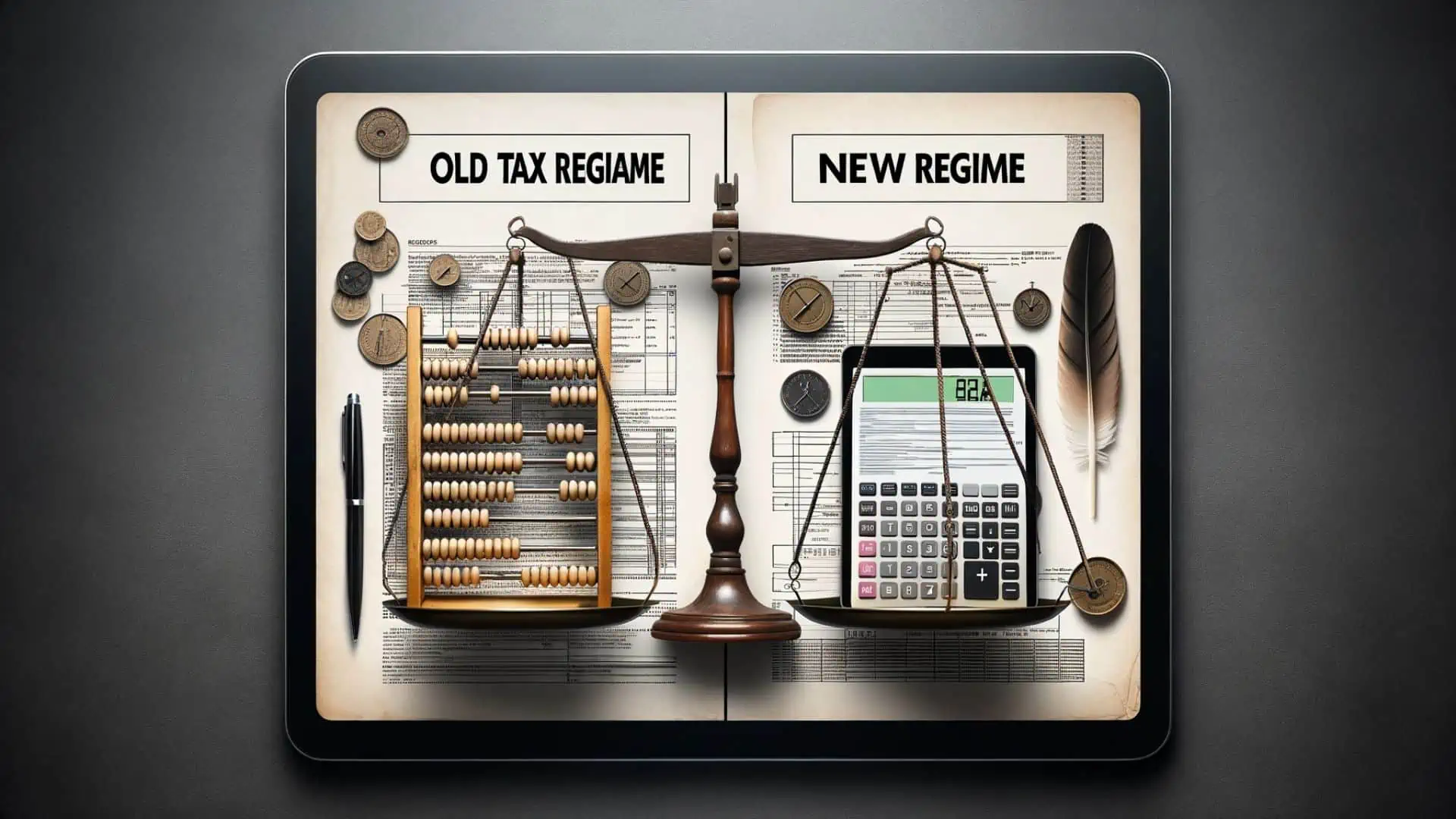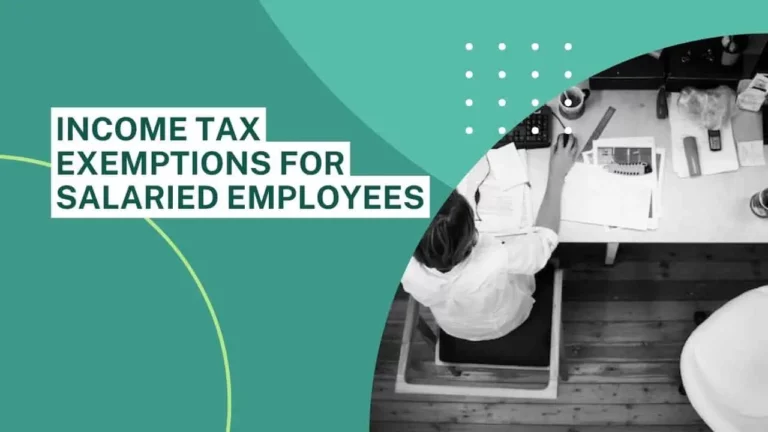Old vs New Tax Regime: Which is Better for You
This post was most recently updated on December 25th, 2023
The Indian government has come up with a new tax system for individuals and large families starting from the year 2020-21. This new system has lower tax rates, but it doesn’t give as many benefits or savings options as the old system. In this article, let’s take a closer look at the Old vs New Tax Regime and understand Which is Better for You.

In the 2023 budget, there were some changes to make this new system more tempting. But picking between the old and new system isn’t easy. It depends on your earnings, type of income, and what benefits or deductions you use.
We’ll look at both systems and help you figure out which is better for you in 2023.
Consider using our Old Vs New Tax Regime Comparison Calculator
Page Contents
Old vs New Tax Regime: Key Difference
| Particulars | Old Tax Regime | New Tax Regime |
|---|---|---|
| Basic exemption limit | Rs. 2.5 lakh | Rs. 3 lakh |
| Tax rates for income slabs | 5%, 20%, and 30% | 5%, 10%, 15%, 20%, and 30% |
| Rebate limit under section 87A | Rs. 12,500 for income up to Rs. 5 lakh | Rs. 17,500 for income up to Rs. 7 lakh |
| Surcharge rates for income above Rs. 5 crore | 37% | 25% |
| Deductions and exemptions allowed | Various deductions and exemptions under different sections of the Income Tax Act, such as section 80C, section 80D, section 10(13A), etc. | Only standard deduction of Rs. 50,000 for salaried taxpayers, deduction of Rs. 15,000 or one-third of family pension for family pensioners, exemption for leave encashment up to Rs. 25 lakh, and exemption for gratuity up to Rs. 20 lakh |
Features of the Old Tax Regime
The old tax regime is the existing tax system that has been in place for many years. Under this regime, taxpayers can avail of various deductions and exemptions under different sections of the Income Tax Act, 1961. Some of the common deductions and exemptions are:
- Standard deduction of Rs. 50,000 for salaried taxpayers
- Deduction under section 80C for investments in specified instruments such as the Public Provident Fund (PPF), National Pension System (NPS), life insurance premium, etc., up to Rs. 1.5 lakh
- Deduction under section 80D for health insurance premium paid for self, spouse, dependent children and parents, up to Rs. 25,000 (Rs. 50,000 for senior citizens)
- Deduction under section 80E for interest paid on education loan
- Deduction under section 80G for donations made to specified funds and institutions
- Deduction under section 80TTA for interest income from savings bank account up to Rs. 10,000
- Exemption under section 10(13A) for house rent allowance (HRA) received by salaried taxpayers
- Exemption under section 10(14) for certain allowances such as leave travel allowance (LTA), conveyance allowance, etc., received by salaried taxpayers
- Exemption under section 10(17A) for awards and rewards received from the government or any other approved body
- Exemption under section 10(34) for dividend income from domestic companies up to Rs. 10 lakh
Consider reading: Income Tax Exemptions Available for Salaried Individuals
The tax rates under the old tax regime are as follows:
| Income Slab | Tax Rate |
|---|---|
| Up to Rs. 2.5 lakh | Nil |
| Rs. 2.5 lakh to Rs. 5 lakh | 5% |
| Rs. 5 lakh to Rs. 10 lakh | 20% |
| Above Rs. 10 lakh | 30% |
In addition to the above rates, a surcharge is levied on the tax amount if the total income exceeds certain thresholds. The surcharge rates are as follows:
| Total Income | Surcharge Rate |
|---|---|
| Above Rs. 50 lakh but up to Rs. 1 crore | 10% |
| Above Rs. 1 crore but up to Rs. 2 crore | 15% |
| Above Rs. 2 crore but up to Rs. 5 crore | 25% |
| Above Rs. 5 crore | 37% |
Further, a health and education cess of 4% is levied on the tax amount plus surcharge.
The old tax regime also provides a rebate under section 87A for taxpayers whose total income does not exceed Rs. 5 lakh. The rebate amount is equal to the tax payable or Rs. 12,500, whichever is lower.
Features of the New Tax Regime
The new tax regime is an optional tax system that was introduced in Budget 2020 and modified in Budget 2023. Under this regime, taxpayers can opt for lower tax rates but have to forego most of the deductions and exemptions that are available under the old tax regime. The only deductions and exemptions that are allowed under the new tax regime are:
- Standard deduction of Rs. 50,000 for salaried taxpayers
- Deduction of Rs. 15,000 or one-third of family pension, whichever is lower, for family pensioners
- Exemption for leave encashment received at the time of retirement up to Rs. 25 lahks (earlier it was Rs. 3 lakh)
- Exemption for gratuity received at the time of retirement up to Rs. 20 lakh
The tax rates under the new tax regime are as follows:
| Income Slab | Tax Rate |
|---|---|
| Up to Rs. 3 lakh | Nil |
| Rs. 3 lakh to Rs. 6 lakh | 5% |
| Rs. 6 lakh to Rs. 9 lakh | 10% |
| Rs. 9 lakh to Rs. 12 lakh | 15% |
| Rs. 12 lakh to Rs. 15 lakh | 20% |
| Above Rs. 15 lakh | 30% |
The surcharge rates under the new tax regime are the same as the old tax regime, except that the surcharge rate for income above Rs. 5 crore has been reduced from 37% to 25%. The health and education cess of 4% is also applicable on the tax amount plus surcharge.
The new tax regime also provides a rebate under section 87A for taxpayers whose total income does not exceed Rs. 7 lakh. The rebate amount is equal to the tax payable or Rs. 17,500, whichever is lower.
Consider reading this Reddit post on How to Save Maximum Tax in India.
Pros and Cons of the Old Tax Regime
The old tax regime has the following advantages and disadvantages:
Pros of the Old Tax Regime
- The old tax regime allows the taxpayers to reduce their taxable income by claiming various deductions and exemptions, which can help them save tax and also achieve their financial goals such as retirement planning, children’s education, etc.
- The old tax regime has a higher basic exemption limit of Rs. 2.5 lakh, which means that taxpayers with income below this threshold do not have to pay any tax at all.
- The old tax regime has a lower tax rate of 5% for income between Rs. 2.5 lakh and Rs. 5 lakh, which can benefit taxpayers with moderate income levels.
- The old tax regime has a higher rebate limit of Rs. 12,500 for taxpayers with income up to Rs. 5 lakh, which can reduce their tax liability further.
Cons of the Old Tax Regime
- The old tax regime has higher tax rates of 20% and 30% for income above Rs. 5 lakh and Rs. 10 lakh respectively, which can increase the tax burden for taxpayers with high income levels.
- The old tax regime has higher surcharge rates of 37% and 25% for income above Rs. 5 crore and Rs. 2 crore respectively, which can further increase the effective tax rate for high net worth individuals (HNIs).
- The old tax regime has a lower exemption limit of Rs. 3 lakh for leave encashment received at the time of retirement, which can reduce the tax-free income for retirees.
- The old tax regime has a complex structure with multiple deductions and exemptions, which can make the tax computation and filing process tedious and cumbersome.
Pros and Cons of the New Tax Regime
The new tax regime has the following advantages and disadvantages:
Pros of the New Tax Regime
- The new tax regime offers lower tax rates of 10%, 15%, and 20% for income between Rs. 6 lakh and Rs. 15 lakh, which can benefit taxpayers with high income levels.
- The new tax regime offers a lower surcharge rate of 25% for income above Rs. 5 crore, which can reduce the effective tax rate for HNIs.
- The new tax regime offers a higher exemption limit of Rs. 25 lakh for leave encashment received at the time of retirement, which can increase the tax-free income for retirees.
- The new tax regime offers a higher basic exemption limit of Rs. 3 lakh, which means that taxpayers with income below this threshold do not have to pay any tax at all.
- The new tax regime offers a higher rebate limit of Rs. 17,500 for taxpayers with income up to Rs. 7 lakh, which can reduce their tax liability further.
- The new tax regime has a simple structure with minimal deductions and exemptions, which can make the tax computation and filing process easy and hassle-free.
Cons of the New Tax Regime
- The new tax regime does not allow taxpayers to claim most of the deductions and exemptions that are available under the old tax regime, which can increase their taxable income and also affect their financial planning.
- The new tax regime has a higher tax rate of 5% for income between Rs. 3 lakh and Rs. 6 lakh, which can increase the tax burden for taxpayers with moderate income levels.
Which Tax Regime is Better for You?
The choice between the old and the new tax regime depends on your individual circumstances such as your income level, nature of income, deductions and exemptions claimed, etc. There is no one-size-fits-all answer to this question, as different taxpayers may have different preferences and goals.
However, as a general rule of thumb, you can follow these steps to decide which tax regime is better for you:
- Calculate your taxable income under both regimes by adding your income from all sources such as salary, interest, dividends, capital gains, etc., and subtracting the deductions and exemptions allowed under the respective regimes.
- Calculate your tax liability under both regimes by applying the applicable tax rates, surcharge, cess, and rebate on your taxable income.
- Compare your tax liability under both regimes and choose the one that results in lower tax payable.
- Consider other factors such as your financial goals, risk appetite, liquidity needs, etc., and decide whether you are willing to forego the deductions and exemptions under the new tax regime or not.
- Review your choice every year and switch between the regimes if your situation changes.
To illustrate this process, let us take an example of a salaried taxpayer who has the following income and deductions for the financial year 2023-24:
| Particulars | Amount (in Rs.) |
|---|---|
| Salary income | 15,00,000 |
| Interest income from savings bank account | 8,000 |
| Dividend income from domestic companies | 12,000 |
| Standard deduction | 50,000 |
| Deduction under section 80C | 1,50,000 |
| Deduction under section 80D | 25,000 |
| HRA exemption | 1,20,000 |
The taxable income and tax liability under both regimes for this taxpayer are as follows:
| Particulars | Old Tax Regime | New Tax Regime |
|---|---|---|
| Gross total income | 15,20,000 | 15,20,000 |
| Less: Deductions and exemptions | 3,45,000 | 50,000 |
| Taxable income | 11,75,000 | 14,70,000 |
| Tax on taxable income | 1,67,500 | 1,87,500 |
| Less: Rebate under section 87A | Nil | Nil |
| Tax payable after rebate | 1,67,500 | 1,87,500 |
| Add: Surcharge | Nil | Nil |
| Tax payable after surcharge | 1,67,500 | 1,87,500 |
| Add: Health and education cess @4% | 6,700 | 7,500 |
| Total tax payable | 1,74,200 | 1,95,000 |
From the above table, it is clear that the old tax regime is better for this taxpayer as it results in a lower tax payable by Rs. 20,800. This is because the taxpayer can claim various deductions and exemptions under the old tax regime that reduce his taxable income significantly.
Consider using our In-hand Salary Calculator to understand how much take-home salary you will receive.
However, if the taxpayer does not have any investments or expenses that qualify for deductions or exemptions under the old tax regime, then he may opt for the new tax regime as it offers lower tax rates for higher income slabs.
Final Thoughts on Old vs New Tax Regime Which is Better for You in 2023
The choice between the old vs new tax regime is a personal one that depends on your individual circumstances and preferences. You should compare both regimes based on your income level, nature of income, deductions and exemptions claimed, etc.
You should also consider other factors such as your financial goals, risk appetite, liquidity needs, etc., and decide whether you are willing to forego the deductions and exemptions under the new tax regime or not. You should review your choice every year and switch between the regimes if your situation changes.
FAQs on Old vs New Tax Regime Which is Better for You in 2023
Which is better old tax regime or new tax regime?
The decision between the old and new tax regimes depends on whether your deductions and exemptions exceed the breakeven threshold for your income level. If they do, sticking to the old regime is recommended. However, if the breakeven threshold is higher, switching to the new regime is more advantageous. Consider your individual circumstances to determine which option is better.
Is new tax regime better than old 2023?
Yes, the new 2023 tax regime may be better if you have a higher income. Budget 2023 states that someone earning INR 9 lakh annually would only pay INR 45,000 in taxes, which is 5% of their taxable income. This new regime could provide more benefits for those with higher incomes.
What are tax benefits in new tax regime?
The tax benefits in the new tax regime include a basic exemption limit of ₹3 lakh and five tax slab rates ranging from 0% to 30%. Individuals can benefit from a maximum tax rate of 30% on income over ₹15 lakh. This new regime offers increased flexibility and lower tax burdens for taxpayers.
Which tax regime is better for 12 lakhs salary?
The old tax regime is better for individuals earning over Rs 12 lakh annually if they can claim deductions exceeding the minimum amount. This regime offers better benefits for higher earners.





